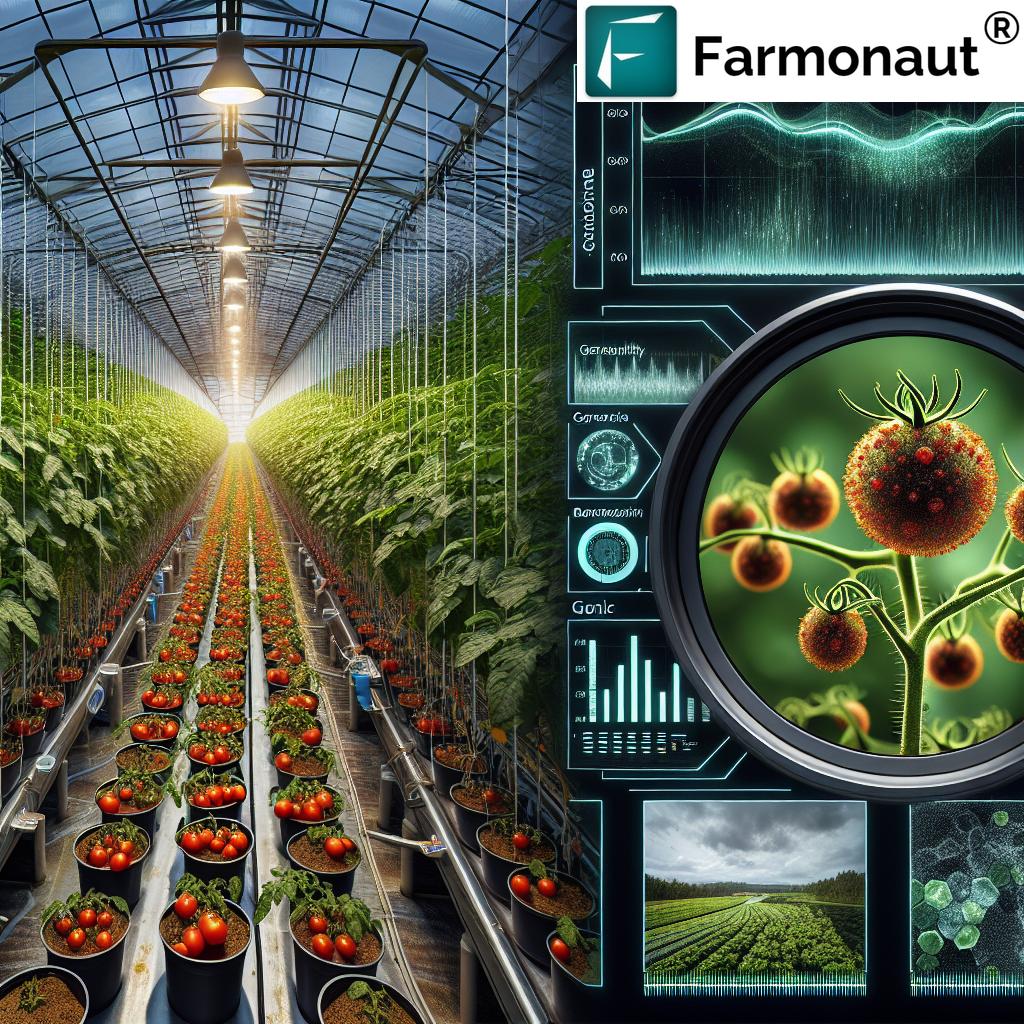Australian Biosecurity Alert: ToBRFV Threatens Tomato Industry Amid National Biosecurity Week
“ToBRFV can cause up to 100% yield loss in tomato crops, potentially devastating Australia’s $1 billion tomato industry.”
As we delve into the heart of National Biosecurity Week, Australia’s horticulture industry faces a formidable challenge that threatens to reshape its landscape. The detection of Tomato Brown Rugose Fruit Virus (ToBRFV) has sent ripples of concern through our agricultural community, highlighting the critical importance of robust biosecurity measures in safeguarding our nation’s food security and economic stability.
In this comprehensive exploration, we at Farmonaut will unpack the implications of this outbreak, examine the response from various sectors, and discuss how innovative agritech solutions can play a pivotal role in managing and mitigating such threats. Our focus on precision agriculture and advanced monitoring technologies positions us uniquely to contribute to this crucial conversation.
Understanding ToBRFV: A New Threat to Australian Horticulture
Tomato Brown Rugose Fruit Virus, commonly known as ToBRFV, is a highly contagious plant pathogen that poses a significant threat to tomato, capsicum, and chilli crops. First identified in Israel in 2014, this virus has since spread to multiple countries, causing substantial crop losses and economic damage. Its recent detection in Australia marks a critical juncture for our horticultural sector.
- Virus Characteristics: ToBRFV belongs to the Tobamovirus genus, known for its resilience and ease of transmission.
- Symptoms: Infected plants may display leaf mottling, fruit discoloration, and deformation, severely impacting crop marketability.
- Transmission: The virus spreads through plant-to-plant contact, contaminated tools, and even seeds, making containment challenging.
The potential impact of ToBRFV on Australian agriculture cannot be overstated. With our country’s tomato industry valued at approximately $1 billion annually, the stakes are exceptionally high. The virus’s ability to cause yield losses of up to 100% in severe cases underscores the urgency of our biosecurity response.

The Australian Context: National Biosecurity Week and Beyond
The timing of this outbreak, coinciding with National Biosecurity Week, serves as a stark reminder of the ongoing challenges we face in protecting our agricultural assets. This annual event, designed to raise awareness about the importance of biosecurity measures, has taken on new significance in light of the ToBRFV threat.
Key Points:
- National Biosecurity Week emphasizes the collective responsibility in safeguarding Australia’s agricultural sector.
- The federal government’s commitment to biosecurity is reflected in substantial funding allocations aimed at strengthening our defenses against invasive pests and diseases.
- The ToBRFV outbreak underscores the need for continuous vigilance and investment in biosecurity infrastructure.
As we navigate this crisis, the collaboration between government bodies, research institutions, and industry stakeholders becomes paramount. The Australian government’s swift response, including enhanced screening measures and support for affected farmers, demonstrates the seriousness with which this threat is being treated.
Impact on the Australian Horticulture Industry
The detection of ToBRFV in Australia has sent shockwaves through our horticulture sector, with implications extending far beyond our borders. Let’s examine the multifaceted impact of this outbreak:
| Crop Type | Estimated Annual Production (tonnes) | Potential Yield Loss (%) | Economic Impact (AUD millions) | Export Restrictions | Biosecurity Measures |
|---|---|---|---|---|---|
| Tomato | 470,000 | Up to 100% | 1,000+ | Yes | Enhanced screening, crop destruction |
| Capsicum | 70,000 | 30-50% | 100-150 | Yes | Increased monitoring, restricted movement |
| Chilli | 5,000 | 20-40% | 10-20 | Yes | Quarantine measures, seed testing |
This table illustrates the potential devastation ToBRFV could wreak on Australia’s horticulture industry. The economic ramifications are significant, with possible losses running into hundreds of millions of dollars.
Export Restrictions and International Relations
One of the most immediate and consequential outcomes of the ToBRFV detection has been the suspension of tomato imports by New Zealand. This decision highlights the interconnected nature of global agricultural trade and the far-reaching impacts of biosecurity breaches.
- Trade Disruptions: The suspension of exports to key markets could lead to oversupply in domestic markets, potentially affecting prices and farmer incomes.
- Reputation Management: Australia’s reputation as a provider of high-quality, disease-free produce is at stake, necessitating transparent communication and swift action to maintain international trust.
- Diplomatic Challenges: Navigating the complexities of international trade agreements and phytosanitary regulations becomes crucial in mitigating the economic impact of export restrictions.
The situation underscores the need for robust traceability systems and stringent quality control measures throughout the supply chain. Here, innovative technologies like blockchain-based traceability solutions can play a pivotal role in restoring confidence in Australian exports.

Biosecurity Measures and Government Response
“Australia’s biosecurity measures protect a $42 billion agriculture industry, highlighting the importance of virus containment efforts.”
The Australian government’s response to the ToBRFV outbreak has been swift and multifaceted, reflecting the seriousness of the threat and the value placed on our agricultural sector. Key components of the response include:
- Enhanced Screening: Increased scrutiny of imported seeds and plant materials at all entry points.
- Quarantine Measures: Strict isolation protocols for suspected cases and affected areas.
- Surveillance Programs: Expanded monitoring efforts to detect and contain potential outbreaks quickly.
- Research Funding: Allocation of resources to develop resistant crop varieties and effective treatment methods.
- Industry Support: Financial assistance and guidance for farmers affected by the outbreak or export restrictions.
These measures aim to contain the spread of ToBRFV while minimizing the economic impact on our horticultural industry. However, the effectiveness of these efforts relies heavily on collaboration between government agencies, research institutions, and farmers themselves.
The Role of Technology in Biosecurity
In the face of evolving agricultural threats, innovative technologies play an increasingly crucial role in strengthening our biosecurity defenses. At Farmonaut, we recognize the potential of advanced remote sensing and AI-driven solutions in early detection and management of plant diseases.
Our satellite-based crop health monitoring system, for instance, can provide valuable insights into vegetation health, potentially identifying anomalies that might indicate the presence of diseases like ToBRFV. By leveraging these technologies, farmers and biosecurity officials can:
- Monitor large areas efficiently, enabling rapid response to potential outbreaks.
- Track changes in crop health over time, facilitating early intervention.
- Make data-driven decisions about resource allocation and containment strategies.
Furthermore, our Jeevn AI Advisory System can offer personalized recommendations to farmers, helping them implement best practices for disease prevention and management. This integration of technology into biosecurity protocols represents a significant step forward in our ability to protect our agricultural assets.
Explore how Farmonaut’s satellite technology is revolutionizing land use in agriculture:
Challenges in Seed Regulation and Import Controls
The ToBRFV outbreak has brought the issue of seed regulation and import controls into sharp focus. As the virus can be transmitted through infected seeds, the integrity of our seed supply becomes a critical point of concern.
Current Regulations and Their Limitations
Australia’s current seed import regulations are designed to prevent the entry of plant pathogens. However, the ToBRFV outbreak suggests that there may be gaps in these defenses. Key challenges include:
- Detection Difficulties: ToBRFV can be present in seeds at levels too low for conventional testing methods to detect reliably.
- Global Supply Chains: The complexity of international seed trade makes tracing the origin of infected materials challenging.
- Balancing Trade and Security: Striking the right balance between facilitating necessary imports and maintaining stringent biosecurity measures.
Addressing these challenges requires a multi-pronged approach, combining enhanced testing methodologies, stricter certification processes, and potentially, the development of domestic seed production capabilities to reduce reliance on imports.
Innovative Approaches to Seed Safety
In response to these challenges, several innovative approaches are being explored:
- Advanced Testing Protocols: Development of more sensitive molecular testing methods to detect viruses in seeds.
- Blockchain Traceability: Implementation of blockchain technology to create an immutable record of seed provenance and testing history.
- AI-Powered Risk Assessment: Utilization of artificial intelligence to analyze global disease data and predict high-risk seed sources.
At Farmonaut, we believe that integrating these technological solutions with traditional regulatory frameworks can significantly enhance our ability to prevent the entry and spread of plant pathogens like ToBRFV.
Learn about Farmonaut’s advanced agri solutions in this case study on precision crop area estimation:
The Future of Plant Disease Management in Australia
As we look to the future, it’s clear that the ToBRFV outbreak will have lasting implications for plant disease management in Australia. This crisis serves as a catalyst for innovation and improvement in our agricultural practices and biosecurity measures.
Emerging Trends and Technologies
- Precision Agriculture: Increased adoption of technologies like Farmonaut’s satellite-based monitoring systems for early disease detection and targeted interventions.
- Genetic Engineering: Development of disease-resistant crop varieties through advanced breeding techniques and genetic modification.
- IoT and Sensor Networks: Deployment of interconnected sensors to monitor environmental conditions and plant health in real-time.
- Big Data Analytics: Utilization of large-scale data analysis to predict disease outbreaks and optimize response strategies.
These advancements promise to revolutionize our approach to plant disease management, making it more proactive, precise, and effective. By embracing these technologies, Australian agriculture can build resilience against future threats and maintain its position as a global leader in food production.
Discover how Farmonaut is making farming better with satellite data:
Conclusion: A Call to Action
The ToBRFV outbreak in Australia serves as a stark reminder of the ever-present threats to our agricultural sector and the critical importance of robust biosecurity measures. As we navigate this challenge, it’s clear that a collaborative, technology-driven approach is essential to safeguarding our horticultural industry and food security.
At Farmonaut, we remain committed to supporting farmers and agricultural stakeholders with cutting-edge technologies that enhance crop monitoring, disease detection, and farm management. Our satellite-based solutions and AI-driven advisory systems offer powerful tools in the fight against plant diseases like ToBRFV.
As we move forward, let us embrace this opportunity to strengthen our biosecurity protocols, invest in innovative technologies, and foster greater cooperation across the agricultural sector. Together, we can build a more resilient and sustainable future for Australian horticulture.
Explore Farmonaut’s solutions:
For developers interested in integrating our satellite and weather data into their systems, check out our API and API Developer Docs.
FAQs
- What is ToBRFV and how does it affect crops?
ToBRFV is a highly contagious plant virus that affects tomatoes, capsicums, and chillies. It can cause severe yield losses and fruit deformation, making crops unmarketable. - How is Australia responding to the ToBRFV threat?
Australia is implementing enhanced screening measures, quarantine protocols, and increased surveillance. The government is also providing support to affected farmers and funding research into resistant crop varieties. - What role can technology play in managing plant diseases like ToBRFV?
Advanced technologies such as satellite monitoring, AI-driven advisory systems, and blockchain traceability can aid in early detection, rapid response, and effective management of plant diseases. - How might the ToBRFV outbreak affect Australian exports?
The outbreak has already led to the suspension of tomato imports by New Zealand. It may result in further export restrictions and impact Australia’s reputation as a provider of high-quality, disease-free produce. - What can farmers do to protect their crops from ToBRFV?
Farmers should implement strict biosecurity measures, regularly monitor crop health, use certified disease-free seeds, and follow guidelines provided by agricultural authorities. Utilizing technologies like Farmonaut’s satellite monitoring can also aid in early detection of potential issues.





